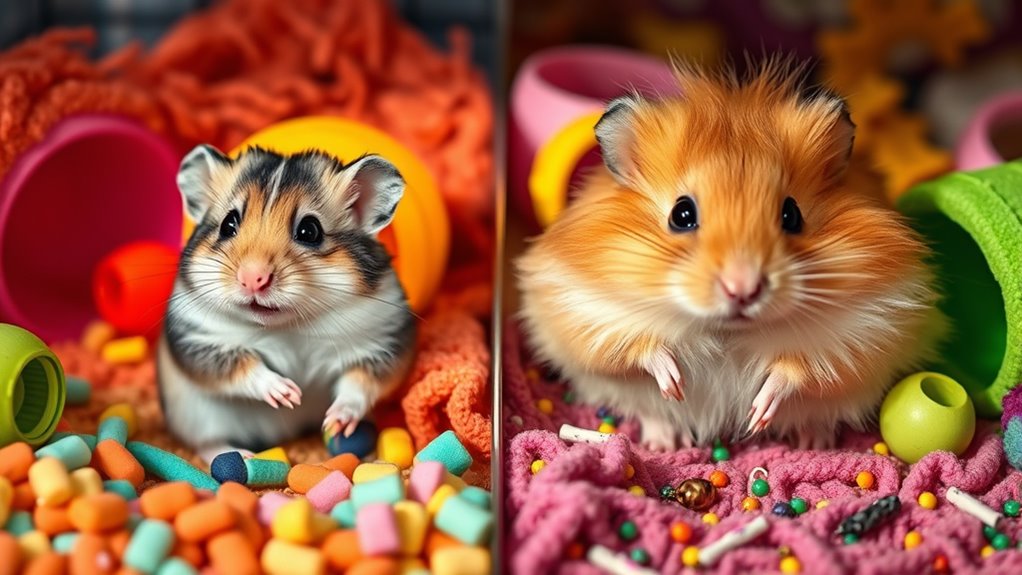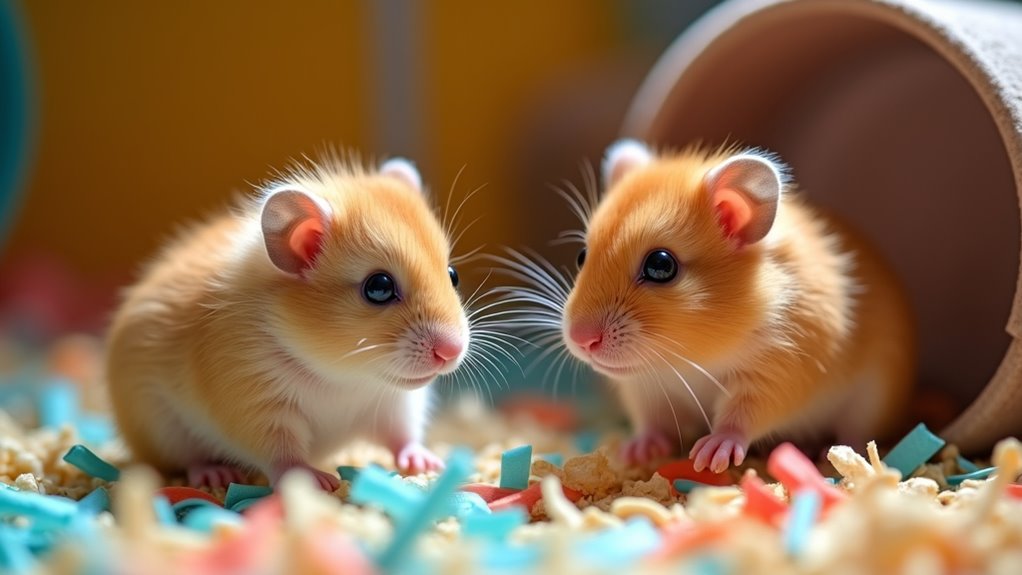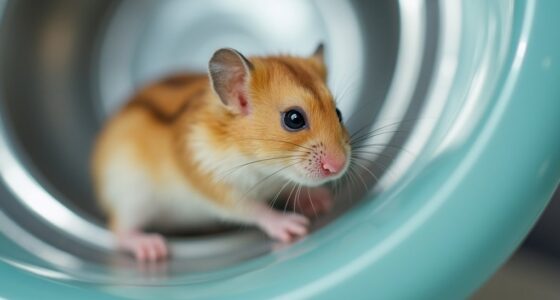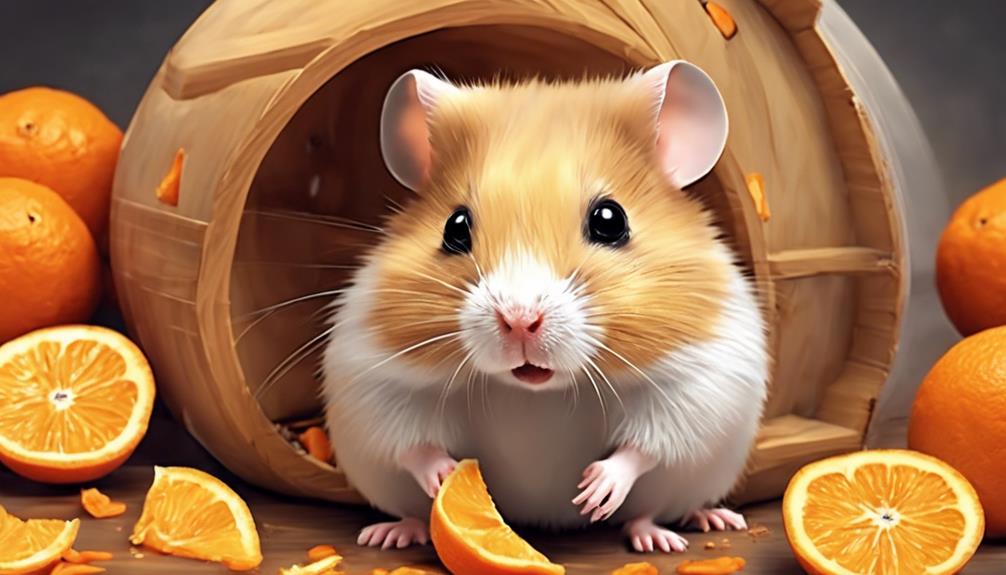Choosing between dwarf and Syrian hamsters depends on your space and handling style. If you want a larger, calmer pet that’s easy to care for, a Syrian hamster may be perfect. However, if you have experience or want a more active, social companion, dwarf hamsters could suit you better — just be prepared for some extra patience and room. Want to find out which hamster matches your lifestyle? Keep exploring to learn more.
Key Takeaways
- Syrian hamsters are larger, calmer, and ideal for first-time owners or children, while dwarf hamsters are smaller, energetic, and better suited for active owners.
- Syrian hamsters prefer solitary living and spacious cages, whereas dwarf hamsters are social and may live in pairs or groups with proper monitoring.
- Dwarf hamsters are more active, curious, and require engaging toys, while Syrian hamsters are more docile and easier to handle.
- Space availability and handling comfort are crucial; large cages benefit Syrians, while dwarfs need stimulating environments and patience.
- Choose based on your lifestyle: Syrians suit calm, beginner-friendly pets; dwarfs are perfect for active, experienced hobbyists.

Are you trying to decide which hamster breed is the best pet for you? Dwarf and Syrian hamsters each have their own unique qualities, so understanding their housing needs and personality traits can help you make the right choice. Syrian hamsters are generally larger, growing up to 5-7 inches, and require more space to thrive. They prefer a spacious cage with multiple levels or a large tank where they can run, explore, and burrow comfortably. Dwarf hamsters are smaller, usually around 2-4 inches, which means their housing needs are a bit different. They can live comfortably in smaller cages, but they still need enough room for exercise wheels, tunnels, and toys to keep them stimulated. Both breeds enjoy clean, well-ventilated environments, but Syrian hamsters tend to be more solitary and territorial, often preferring to live alone to avoid fighting. Dwarfs, on the other hand, are often more social and might do well in pairs or small groups if introduced properly, but they can also be aggressive, especially males.
When it comes to personality traits, Syrian hamsters are typically more docile and easier to handle, making them ideal for first-time pet owners or children. They tend to be calmer and more tolerant of handling, but they also prefer their own space and can become stressed if disturbed too often. Dwarf hamsters are usually more active and curious, which means you’ll see them exploring their environment more vigorously. They can be a bit more nervous and skittish, especially at first, so patience and gentle handling are key. Dwarfs often have a playful and energetic personality that keeps their owners entertained, but they might be less tolerant of handling compared to Syrians. Additionally, understanding the importance of proper diet and nutrition can significantly impact their health and longevity.
Both types of hamsters have distinct personality traits that influence how you should care for them. Syrian hamsters are more straightforward to care for if you’re looking for a calmer, more manageable pet. Dwarfs require a bit more observation and patience because of their energetic and sometimes unpredictable behavior. Ultimately, your decision should be based on your lifestyle, how much space you have, and your comfort level with handling. If you want a larger, calmer pet that’s easier to handle, a Syrian hamster might be the best fit. However, if you’re looking for an active, social little companion and have the space and patience to accommodate their needs, a dwarf hamster could be a great choice.
Frequently Asked Questions
Which Hamster Breed Is More Suitable for Children?
When choosing a hamster breed for children, consider which is more child-friendly and suitable for beginners. Dwarf hamsters are often more manageable and less intimidating, making them ideal for kids new to pet care. They’re typically more active and curious, helping children learn responsibility. Syrian hamsters, however, can be more territorial and require more careful handling. Overall, dwarf hamsters tend to be the best choice for beginner pet suitability and child-friendly hamsters.
How Often Do Dwarf and Syrian Hamsters Need Veterinary Care?
Think of your hamster’s health as a delicate garden that needs regular care. Dwarf and Syrian hamsters typically require veterinary visits once a year for routine check-ups. Keep an eye on their behavior and appearance, and seek vet care promptly if you notice signs of illness. Regular veterinary visits help catch issues early and guarantee your tiny friend stays happy and healthy, just like a well-tended garden.
Are There Significant Differences in Lifespan Between the Two Hamsters?
You might wonder about hamster lifespan and longevity differences between dwarf and Syrian hamsters. Generally, dwarf hamsters tend to live slightly longer, averaging 2 to 3 years, while Syrian hamsters usually live around 1.5 to 2 years. Your choice can depend on these longevity differences, but remember, proper care and a healthy environment profoundly impact your hamster’s lifespan. Both can make wonderful pets if well looked after.
Which Hamster Type Is More Prone to Health Issues?
Think of choosing a hamster as steering through a delicate garden. Dwarf hamsters are more prone to health complications due to genetic disorders, making them delicate blooms that need extra care. Syrian hamsters, while generally hardy, can still face health issues but tend to be more resilient. You’ll want to stay vigilant with dwarf varieties, providing regular check-ups to prevent minor issues from blossoming into serious problems.
Can Dwarf and Syrian Hamsters Share the Same Cage?
You shouldn’t keep dwarf and Syrian hamsters in the same cage because of cage compatibility issues and sharing precautions. Dwarfs are smaller and more social, while Syrians prefer solitude. Mixing them can lead to fighting, stress, or injuries. To keep both safe and healthy, provide separate cages and never share bedding or toys. This guarantees each hamster’s needs are met and reduces risks associated with sharing living space.
Conclusion
So, now you know which hamster suits your lifestyle—dwarf’s tiny charm or Syrian’s bigger personality. Truly, the choice is obvious: pick the one that’ll keep you up all night or the one that’ll nap through your Netflix binge. Either way, you’ll have a tiny, adorable roommate who’s more likely to run in circles than help with chores. So go ahead—embrace your inner hamster parent and enjoy the endless wheel of tiny drama!










